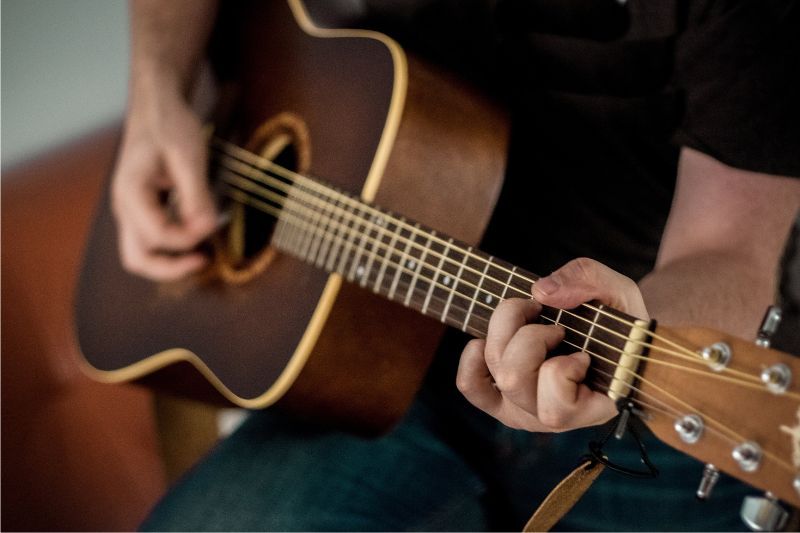No products in the cart.
Tackling The Challenge of Guitar Mastery: Unlock Your Inner Artist

The guitar, with its beautifully carved wooden body and gleaming strings, is a musical instrument cherished worldwide. Dating back over 4,000 years, this celebrated instrument has undergone numerous transformations leading to the modern classical and electric variations we are familiar with today. Its delightful panorama of sounds — from the soft dulcet tones of a finger-picked melody to the electrifying roar of a rock solo — can express a vast spectrum of human emotions.
Strumming the Strings: The Allure and Respect for Guitar Playing
The popularity of learning to play the guitar spans across generations and cultures, making it one of the most sought-after musical skills. And because there are so many free online resources (like Stay Tuned Guitar), it’s never been easier! Its versatility in playing different genres, portability unlike grand pianos or drum sets, and its pivotal role in popular music have contributed to its widespread adoration.
Furthermore, playing this beloved instrument provides numerous benefits such as enhanced coordination, cognitive development, and stress relief, plus it’s an impressive skill that appeals both personally and socially.
The Path Less Traveled: Unveiling the Complexities in Mastering Guitar
While many are captivated by the allure of strumming their favorite tunes or possibly creating their own compositions on a guitar, they’re often met with hard realities when they begin their journey. The path to becoming proficient at guitar playing is fraught with challenges that extend beyond mere enthusiasm or purchasing a decent instrument. This article aims to dissect why learning guitar can be particularly difficult by addressing physical issues such as dexterity and posture; cognitive hurdles concerning music theory comprehension; emotional aspects like patience; and unraveling each aspect meticulously.
The Challenges in Learning Guitar: An Overview
The Physical Trials of Taming the Strings
One’s journey to master the art of guitar playing often begins with a series of physical challenges. The strength and dexterity required to deftly navigate the fretboard can take time for neophytes to develop.
Each finger must press down on the strings with firmness and precision to effectively produce clear, resonant notes, a feat that requires both physical strength and flexibility. This is especially taxing when forming chords, where multiple fingers are required to exert pressure simultaneously on different strings.
Hand-eye coordination also plays an integral role as one learns strumming and picking patterns while navigating the fretboard. Proper posture – the positioning of hands, arms, and even how one holds the instrument – cannot be overlooked as it not only aids in efficient playing but is essential in preventing strain or injuries.
Navigating Cognitive Conundrum: Harmonizing Theory with Practice
Beyond these physical demands lies an array of cognitive challenges that can seem labyrinthine for aspiring guitarists. A fundamental understanding of music theory is paramount for any musician; it serves as a map guiding players through scales, chord progressions, rhythm patterns, and many other key elements that constitute a piece of music.
Reading sheet music or tablature can initially appear arcane but becomes indispensable when learning new pieces or composing original ones. Additionally, memorizing various chord shapes and scale patterns often equates to an exercise in mental gymnastics as one grapples with committing these myriad formations to memory.
Emotional Peaks & Valleys: From Frustration Through Perseverance
The roller-coaster journey of mastering guitar inevitably elicits emotional challenges along its path. Possibly being unable to play a desired song from day one or struggling with seemingly insurmountable techniques can lead to frustration for many novices.
Patience then becomes an indispensable virtue; understanding that proficiency comes not overnight but through consistent practice over weeks or even months is crucial in maintaining motivation during this learning phase. Moreover, perseverance forms the cornerstone upon which successful musicians are built – sticking through difficult practice sessions, and dusting oneself off after failed attempts at mastering techniques or songs; it’s about continuously striving for improvement despite obstacles encountered along this musical expedition.
Deep Dive into Physical Challenges
A Journey into the Crucible of Finger Strength and Dexterity
Learning to play the guitar often starts with a baptism by fire for your fingers. The strength and dexterity required to fret notes and chords on the guitar can be daunting for beginners. Uncooperative fingers may feel stiff or weak against the relentless steel strings, leading to inaccuracies in fretting or declining speed.
Inevitable Calluses: A Rite of Passage for Guitarists
While it may sound intimidating, calluses are an integral part of playing guitar. They form over time as a natural protective response to repeated pressure and friction on your fingertips. Initially, it’s painful as blisters form and break open, but eventually, they recede into hardened skin patches that make pressing down on guitar strings less painful.
Nurturing Finger Strength and Flexibility: Techniques for Success
Building finger strength requires dedication but isn’t as hard as one might think. It involves exercises like spider walks (a routine where one ‘walks’ their fingers up and down the neck of the guitar) or barre chord practice. On the other hand, finger flexibility is often achieved through stretching exercises before playing sessions which can include finger extension exercises or curling and uncurling fingers rapidly.
Proper Posture: The Unsung Hero of Playing Guitar
Many budding guitarists underestimate the importance of proper posture when playing an instrument—it’s not just about comfort but also about reducing strain while allowing free movement. When holding a guitar, ensure it’s close to your body, with your fretting arm forming roughly a right angle at the elbow. Sitting straight-backed ensures optimal breathing while keeping potential backaches at bay.
The Intricacies of Hand-Eye Coordination in Guitar Playing
Picking Patterns & Strumming: More Than Just Fancy Hand Work
In learning guitar, you’re training your hands to move independently yet symbiotically – strumming hand setting rhythm whilst your fretting hand navigates note changes smoothly. This interplay becomes more complex within fingerpicking styles where distinct patterns emerge requiring even sharper hand-eye coordination.
Improving Coordination & Accuracy: Tried-and-True Strategies
Developing effective coordination between hands takes practice but rest assured there are strategies that work wonders:
1) Slow Practice – It might seem counterintuitive but practicing slowly allows you to focus on accuracy rather than speed which eventually improves coordination considerably.
2) Mental Rehearsal – Visualizing chord shapes before you play them helps reduce reaction time during actual play giving your hands greater syncing capability.
Cognitive Challenges Explored: The Mind Behind the Strings
Understanding Music Theory: More Than Just Strumming Strings
The importance of music theory in playing guitar effectively cannot be underestimated. It is the grammar and syntax of the musical language, providing a structural framework within which melodies and harmonies come to life.
Understanding music theory enhances your capacity to create, interpret, and appreciate music more profoundly. However, many budding guitarists encounter struggles when trying to comprehend the abstract nature of music theory.
The notation system is symbolic and often appears daunting to beginners who must learn to translate these symbols into sounds. Scales, modes, intervals – these concepts can seem overwhelming initially but are crucial for progressive learning.
Reading Sheet Music & Tablature: Deciphering Musical Codes
Two key notational systems exist for guitarists: standard notation (also known as sheet music) and tablature. Standard notation depicts notes on a stave indicating pitch and rhythm whereas tablature or ‘tabs’ illustrate where on the fretboard each note should be played; a more visual approach specific to stringed instruments.
Mastery of both methods expands versatility as a player. For standard notation, start by familiarizing yourself with note values and their placement on the stave.
Practice sight-reading regularly but initially concentrate on short simple pieces before progressing onto complex compositions. As for tabs, start by learning common chord diagrams and practice reading tabs while simultaneously listening to their corresponding songs to develop an ear for melody along with rhythm matching.
Memorizing Chords & Scales: Building Blocks of Melodies
The ability to play chords fluently is fundamental in most styles of guitar playing while scales form an essential part of improvisation and solo work. Chords are essentially several notes played simultaneously creating harmony while scales are sequences of notes played individually forming melodic constructs.
To ease chord memorization, begin with open chords such as E minor or A major before moving onto barre chords which utilize similar shapes across different frets thus reducing memorization workload. For scales learn one at a time thoroughly; understand its shape pattern along the fretboard and practice it repeatedly until it becomes second nature before moving on to another scale variety.
Emotional Challenges Unveiled: The Heartstrings of Learning Guitar
Dealing with Frustration:
No path to mastery is linear, and this holds true for the journey to proficient guitar playing. One of the most pervasive emotional challenges encountered is frustration.
Often, it stems from a combination of high expectations and slow progress, or even perceived regressions in skill level. This sensation can be compounded by difficulties in physically manipulating the instrument or grasping complex aspects of music theory.
It’s crucial to understand that frustration is an integral part of the learning process, almost a rite of passage for every aspiring guitarist. Frustration can be mitigated by adopting healthy coping strategies such as setting realistic goals, practicing mindfulness, and celebrating small victories rather than focusing solely on shortcomings.
It often helps to break down large objectives into smaller achievable tasks. Appreciate each chord that rings out cleaner than before or every transition that feels slightly smoother – these are signs of progress!
Cultivating Patience: A Virtue Rewarded
Another emotional challenge while learning guitar is impatience; the desire for immediate results can often lead one astray from the path of steady growth. Patience becomes paramount when undertaking an endeavor as complex as learning an instrument. The key lies not just in recognizing patience as a virtue but in actively cultivating it.
One way to do this is by practicing delayed gratification – focus more on practicing consistently rather than searching for shortcuts to success. Remembering that even accomplished musicians started from scratch and moved through their own struggles can also foster patience.
Perseverance in Practice: The Keynote to Mastery
Beyond frustration and impatience lies another realm – perseverance – which forms the cornerstone in achieving mastery over any skill especially one as intricate as guitar playing. Perseverance goes beyond mere repetition; it involves approaching practice with determination even on days when motivation wanes low. It requires understanding that every practice session brings you one step closer to your goal – regardless if it was a good or bad practice day.

Striking A Chord with Resilience
In essence, learning guitar isn’t just about mastering chords; it’s also about mastering oneself — honing patience, battling through frustrations, and fostering perseverance — a symphony within itself! While undeniably challenging at times, remember that each strum echoes your resilience on this journey toward harmony between your heartstrings and those within your hands.















Leave a Reply